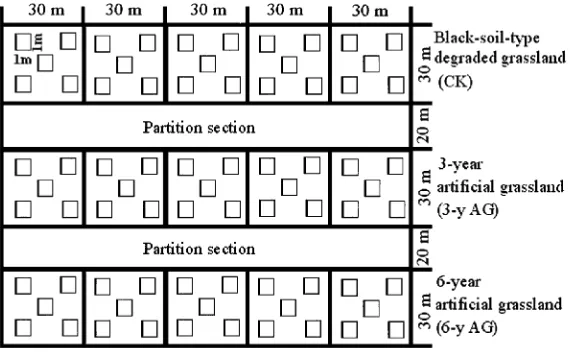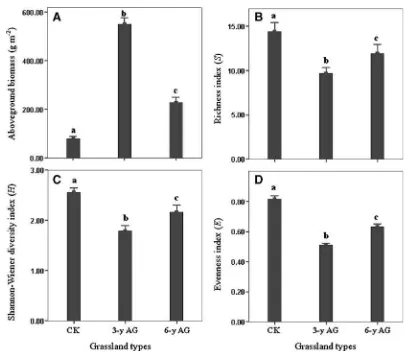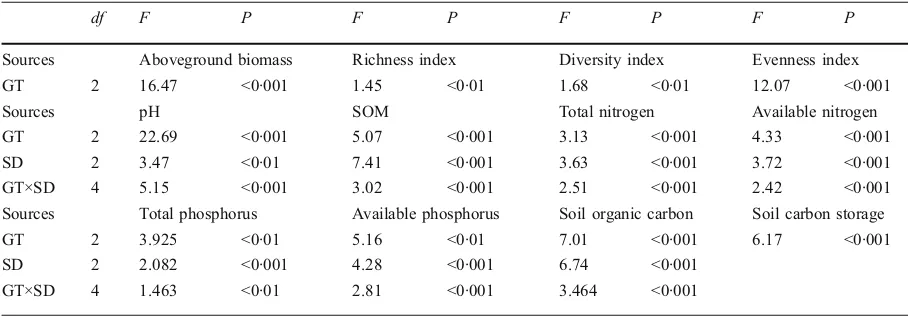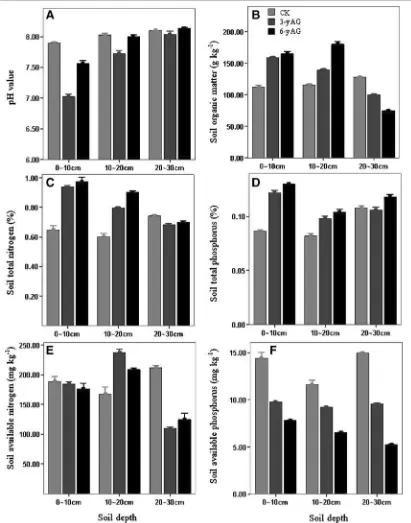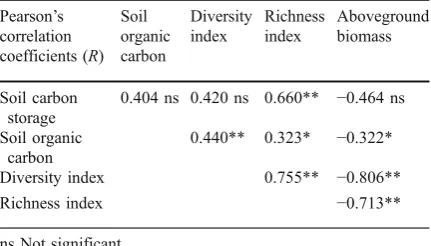REGULAR ARTICLE
Effects of artificial grassland establishment on soil nutrients
and carbon properties in a black-soil-type degraded
grassland
Gao-Lin Wu&Zhen-Heng Liu&Lei Zhang& Tian-Ming Hu&Ji-Min Chen
Received: 12 October 2009 / Accepted: 22 March 2010 / Published online: 23 April 2010
#Springer Science+Business Media B.V. 2010
Abstract Disturbance and management approaches can contribute significantly to restoration of degraded grassland ecosystems. This study has examined the re-establishment of artificial grassland to renew extremely degraded black-soils in an alpine area of the Qinghai-Tibetan Plateau, in China. We evaluated this method for which grassland ecosystem responses
to this restoration approach are needed. Here, we evaluated the response of aboveground plant commu-nities and belowground soil nutrient and soil carbon storage to the establishment of artificial grassland in grasslands on black-soils in the eastern Qinghai-Tibetan Plateau. Three grasslands sites were selected: a degraded grassland on an original black-soil, and 3-and 6-year-old Elymus nutans artificial grasslands. Artificial grassland establishment significantly im-proved aboveground biomass, but also significantly decreased species richness, diversity and evenness for black-soil-type degraded grassland. Artificial grass-land establishment resulted in significantly improved soil total nitrogen and phosphorus, and decreased soil organic matter, available nitrogen, and phosphorus, especially in the depth of 20–30 cm soil layer. Although artificial grassland establishment signifi-cantly improved soil organic carbon in the topsoil (0–10 cm), it decreased at depths of 10–20 and 20– 30 cm. Six-year artificial grassland significantly increased soil carbon storage compared with black-soil-type degraded grasslands. Accordingly, artificial grassland can be used as effective restoration and rehabilitation approach to improve productivity and regulate community and soil properties in black-soil-type degraded grasslands. Our results suggest that ecosystem functions such as production of above-ground biomass, the provision of soil surface cover, and nutrient accumulation may be provided by artificial grassland. However, more time is needed DOI 10.1007/s11104-010-0363-9
Responsible Editor: Tibor Kalapos.
G.-L. Wu
:
L. Zhang:
J.-M. ChenState Key Laboratory of Soil Erosion and Dryland Farming on the Loess Plateau of Northwest A&F University, Yangling 712100 Shaanxi, People’s Republic of China
G.-L. Wu
:
T.-M. Hu (*):
J.-M. Chen (*)College of Animal Science & Technology of Northwest A&F University,
Yangling, Shaanxi 712100, People’s Republic of China e-mail: hutianming@126.com
e-mail: gyzcjm@ms.iswc.ac.cn
Z.-H. Liu
Maqu Alpine Grassland Workstation,
Maqu, Gansu 747300, People’s Republic of China
G.-L. Wu (*)
:
J.-M. ChenState Key Laboratory of Soil Erosion and Dryland Farming on the Loess Plateau, Institute of Soil and Water
Conservation of CAS&MWR, No. 26 Xinong Road,
for plant diversity and soil carbon storage functions to recover fully from degradation.
Keywords Alpine grassland . Artificial grassland establishment . Community . Soil carbon storage . Soil properties . Succession
Introduction
Restoration of degraded grassland ecosystems has become an increasingly important research subject, not at least due to increasing problems associated with ecosystem functioning, e.g., maintenance of biodiversity and carbon sequestration (Tiessen et al.
1994; Neill et al.1997). In China, 90% of grasslands (3.99 billion ha) are degraded (Ren et al.2007a), and in recent years, alpine grasslands on the Tibetan Plateau have also suffered from quite severe degra-dation. This has resulted in both a decline in herbage yields and ecological quality of the environment, with severe pest damage, species loss, desertifica-tion, wetland degradadesertifica-tion, soil erosion, etc. (Hao
2008). Globally, grassland ecosystems play impor-tant roles both as sinks and sources of atmospheric carbon with soils being the largest source of uncertainty in the terrestrial carbon balance (Piao et al.2009). Grassland ecosystems can influence global environmental change through their strong potential for carbon and nitrogen sequestration (Wright et al.
2004). An important component of “disturbance”, restoration and rehabilitation modes of natural degraded grassland ecosystems has a potential to alter not only the aboveground community, but also belowground soil properties and the soil carbon-sink function (Lal 2004; Wright et al. 2004; Piao et al.
2009). Wang et al. (2005) found that artificial grassland establishment followed by fencing could significantly enhance soil C and N concentrations in alpine grassland. External disturbance can not only accelerate succession of vegetation, but also renew soil nutrient cycling and carbon storage (Schippers and Joenje2002). Accordingly, to counteract degra-dation, approaches, such as fencing, reseeding and/ or the use of fertilizers, control of rats, were conducted to accelerate the restoration and rehabil-itation process of degraded grassland ecosystems (Akiyama and Kawamura 2007; Choi 2007; Wu et al.2009).
However, none of these restoration and rehabilita-tion approaches have shown significant positive effects on degraded grassland black-soils in alpine areas of the Qinghai-Tibetan Plateau (Shang and Long
2007). This is largely a consequence of the special and extremely degraded conditions of these soils (Shang and Long2007; Shang et al.2008). Favorable natural restoration approaches have been found to be difficult to establish. Black-soil-type degraded grass-lands, which range from 10 to 15 cm in depth, occur after complete removal of surface layer by intensive grazing and activities of rodents leaving the sub-soil uncovered (Shang and Long2007). In the cold season especially, it is not covered with vegetation, which leaves the soil bare and prone to erosion, while in the warm season grasslands are covered by toxic weeds, inedible for livestock (Shang and Long2007). This not only leads to ecological problems, but also greatly reduces the productivity of those grasslands. The common restoration and rehabilitation approach to this degradation is an establishment of artificial and semi-artificial grassland (Shang and Long2007; Shang et al.
2008). Although more recent studies focus on effects of different restoration and management on plant species composition and diversity, soil properties and soil carbon and nitrogen dynamics (Smith et al.2000; Burke2001; Wright et al.2004; Shang et al.2008; Wu et al.2009), relatively little information is available on artificial grassland establishment, which may be seen as a stronger disturbance on natural grassland, affecting soil properties and the soil carbon-sink function in a black-soil-type degraded grassland ecosystem of the Qinghai-Tibetan Plateau.
Materials and methods
Study sites
This experiment was conducted in alpine meadow at 3,500 m a.s.l. at Manrima (33°42′21″N, 102°07′02″ E) in Gansu Province, PR China, which is located at the eastern Qinghai-Tibetan Plateau. The mean annual temperature is 1.2°C, ranging from −10°C in January to 11.7°C in July, with about 270 frost days. The mean annual precipitation is 620 mm, with a main rain period during a short, cool summer. The annual cloud-free solar radiation was about 2,580 h (Wu et al. 2009). The vegetation is typical alpine meadow and is dominated by clonal grasses (Festuca ovina, Poa poophagorum, Roegneria nutans, Agrostis sp., Kobresia sp., grasses and sedges) and forbs (Saussurea sp., Asteraceae and Anemone rivularis, Ranunculaceae).
In this study, we selected a highly degraded black-soil-type grassland, in the alpine area of the Qinghai-Tibetan Plateau, which was dominated by Potentilla anserinaL. andHelenia corniculata (L.) Cornaz and some other subordinate species.
Experimental design
In this study, we compared three grasslands: a black-soil-type degraded, and 3-year and 6-year artificial
establishment of Elymus nutans. Each grassland plot was about 0.5 ha and comprised five sampling plots (30 m×30 m) (Fig.1). Plots were separated by fences with a partition section of 20 m. Artificial grassland plots were excluded from livestock grazing with fencing during the plant growth seasons from April to October, and slight grazing was provided for Tibetan sheep and yaks (1.3 individuals per hectare with a ratio sheep vs yaks of 2:1) only during the hay-stage in winter. In each of the five sampling plots of the three grassland types, we established five diagonal sampling quadrats (1 m×1 m) (Fig. 1).
Vegetation sampling
All plant species composition samples were taken from five quadrats from every sampling plot, when peak biomass was reached (early September 2008). The experiment contained a total of 75 quadrats. The density, frequency and biomass of each species in each quadrat were counted separately. Total above-ground biomass, species richness, and abundance of each quadrat in three grassland types were measured. Every shoot was counted for each species, clipped and put in marked paper bags per species per quadrat. We determined the total dry biomass in every quadrat by weighing the plants after drying at 80°C for 48 h to a constant weight. The mean number of shoots in sampling plots represented the abundance of the
Fig. 1 Field experiment setup and sampling arrangement. Three grassland types were contained (black-soil-type degraded grassland CK, 3-year artificial grassland3-y AG, and 6-year artificial grassland 6-y AG) and five sampling plots (30 m×
community. Shannon-Wiener diversity index (H) and Evenness index (E) of the three grassland types communities were calculated as:
Richness index (R): R=S
Shannon-Wiener diversity index (H):
H¼−P
where S is the total species numbers of meadow community, His the Shannon-Wiener diversity index and Piis the abundance proportion ofispecies.
Soil sampling
We collected five soil samples at different soil depths (from 0∼10 cm, 10∼20 cm and 20∼30 cm respective-ly) using a bucket auger from each quadrat and every sampling plot in the three grassland types in a diagonal pattern. Soil samples at the same depths in each sampling quadrat were mixed. Then, 25 mixed soil samples from each soil depth in each plot were used to analyze soil properties and soil carbon storage. All soil samples were air-dried and then passed through a 0.14-mm sieve. Soil pH was determined using a soil–water ratio of 1:5. Soil organic matter was measured using the Walkley-Black acid digestion method by K2Cr2O7 (Soil
Science Society of China 1983). Soil total nitrogen, available nitrogen, total phosphorus and available phosphorus were measured by the methods of Miller and Keeney (1982) in the laboratory. The organic carbon content in the soil samples were determined by wet oxidation with potassium dichromate (K2Cr2O7)
and dry combustion with a carbon analyzer using a Mebius method by the Walkley-Black acid digestion (Nelson and Sommers1982). We calculated the total soil organic carbon storage density (TSOC, g cm−2) by the method of He et al. (2008) on a ground area basis up to a 30-cm depth as follows:
TSOC¼
X
DiPiOMiS
where Di, Pi, OMi, and S represent, respectively, the soil thickness (cm), bulk density (g cm−3), organic carbon concentration (%), and cross-sectional area (cm-2) of theith layer;i=1, 2, and 3.
The content of each nutrient trait calculated by the proportions of soil organic matter, total nitrogen, available nitrogen, total phosphorus and available phosphorus account for air-dry weight of soil samplings.
Data analysis
Data is expressed as mean±standard error of mean. The soil sample data for the 0–10-cm, 10–20-cm and 20–30-cm soil layers were used to analyze the soil properties and soil organic carbon storage potentials of the three grassland types. To assess the effects of establishment time of artificial grassland on soil depth and their interaction on soil properties and soil organic carbon, an LSD tests for significance (P< 0.05) of between-subjects effects were conducted with two-way ANOVA of General Linear Model (GLM) for soil properties and soil organic carbon among three grassland types and three soil depths. To assess the effect of establishment time of artificial grassland on community properties and soil carbon storage, one-way ANOVA analyses were conducted for vegetation community characteristics and soil carbon storage among three grassland types. All statistical analyses were performed using the software program SPSS, ver. 13.0 (SPSS, Chicago, IL, USA).
Results
Response of plant community and soil nutrient properties
greater than black-soil-type grassland at depths of 0– 10 and 10–20 cm, but opposite results were shown at a depth of 20–30 cm (Fig. 3b,c). The soil available nitrogen at depths of 0–10 and 20–30 cm in the 3-year and 6-year artificial grasslands were lower than those for black-soil-type grassland, but increased at depths of 10–20 cm (Fig.3e).
In two different growth periods, the 6-year artifi-cial grassland had higher pH, total soil nitrogen and phosphorus throughout the soil profile. The organic matter concentrations were higher in the 0–10 and 10–20 cm layers, but lower at 20–30 cm than the 3-year artificial grassland. Additionally, 6-3-year artificial grassland had lower soil available phosphorus throughout the profile and lower soil available
nitrogen at depths of 0–10 and 10–20 cm, but greater at 20–30 cm than the 3-year artificial grassland (Fig. 3).
Response of soil carbon properties
There was a significant effect of grassland type, soil depth and their interaction on soil organic carbon (Table 1). Three-year and 6-year artificial grasslands both showed a significant increase in soil organic carbon content at a depth of 0–10 cm, but there were lower concentrations between 10–20 and 20–30 cm. Meanwhile, 6-year artificial grassland had a higher soil organic carbon content than the 3-year artificial grassland (Fig. 4a).
Fig. 2 Effect of artificial grassland planting on aboveground biomass (a), species richness index (b), Shannon-Wiener diversity index (c) and Evenness index (d) of grassland community. Values (±SE) are means of 25 quadrates for
For soil carbon storage, the three grassland types showed significant differences (Table1). The amount of C in 6-year artificial grassland was greater than that in black-soil-type degraded grassland, which was in turn greater than that in 3-year artificial grassland (Fig.4b).
Correlation analyses showed that soil carbon storage was significant positively related to richness index (R=0.660, P<0.01). There was also a non-significant positive correlation between soil carbon storage and the diversity index (R=0.420, P>0.05). Meanwhile, soil organic carbon was significantly positively related to diversity index (R=0.440, P< 0.01) and richness index (R=0.323,P<0.05), but was significantly negatively related to aboveground bio-mass (R=-0.322,P<0.05; Table2).
Discussion
Rebuilding of artificial grassland of Elymus nutans is central for restoration of vegetation productivity in black-soil-type degraded grassland. Six-year artificial grassland showed significantly less above-ground biomass than 3-year artificial grassland. It was consistent with the results of Ma et al. (2002) and Kanda et al. (2002), who have demonstrated that artificial grassland establishment in black-soil lands can slow the pace of grassland degradation
and, concomitantly, can produce more feed for livestock.
Establishment of artificial grassland significantly reduced plant diversity and evenness of black-soil-type degraded grassland at 3 years. But, at 6 years, plant diversity and evenness had rebounded and began increasing relative to that at 3 years. This result was consistent with a study in‘black-soil land’ grassland in the headwaters of the Yangtze and the Yellow Rivers of the Qinghai-Tibetan Plateau by Shang et al. (2008). They had found that species richness of forbs decreased but grass species in-creased in re-established artificial grassland more than in black-soil-type degraded grassland. Meanwhile, reseeding grasses could significantly change the plant composition of black-soil-type degraded grassland in the short-term, and increase the proportion of the functional group of grasses (Shang et al.2008). This is also related to a stronger growth and competitive advantage shown by Elymus nutans. Previous re-search has reported that palatable grasses have greater competitive ability and show a greater increase in abundance in grasslands than unpalatable grasses where livestock are excluded (Distel and Boo 1996; Moretto and Distel 1997; Gallego et al. 2004). Furthermore, palatable grasses which had higher productivity and quality can lock abundant nutrients within their tissues from the soil (Moretto and Distel
1997; Harris et al. 2007). Additionally, the Elymus Table 1 Results of ANOVA tests for the effects of grassland type (GT) on aboveground biomass, species richness, diversity, evenness and soil carbon storage over the depth of 0∼30 cm, and effects of grassland type (GT), soil depth (SD), and their interaction (GT×SD)
on pH value, soil organic matter (SOM), total nitrogen, available nitrogen, total phosphorus, available phosphorus and soil organic carbon
df F P F P F P F P
Sources Aboveground biomass Richness index Diversity index Evenness index GT 2 16.47 <0·001 1.45 <0·01 1.68 <0·01 12.07 <0·001
Sources pH SOM Total nitrogen Available nitrogen
GT 2 22.69 <0·001 5.07 <0·001 3.13 <0·001 4.33 <0·001 SD 2 3.47 <0·01 7.41 <0·001 3.63 <0·001 3.72 <0·001 GT×SD 4 5.15 <0·001 3.02 <0·001 2.51 <0·001 2.42 <0·001 Sources Total phosphorus Available phosphorus Soil organic carbon Soil carbon storage GT 2 3.925 <0·01 5.16 <0·01 7.01 <0·001 6.17 <0·001 SD 2 2.082 <0·001 4.28 <0·001 6.74 <0·001
GT×SD 4 1.463 <0·01 2.81 <0·001 3.464 <0·001
All values show significance atP<0·05 dfDegrees of freedom
Table 1 Results of ANOVA tests for the effects of grassland type (GT) on aboveground biomass, species richness, diversity, evenness and soil carbon storage over the depth of 0∼30 cm, and
effects of grassland type (GT), soil depth (SD), and their
Fig. 3 Changes (mean±SE) in soil pH value (a), soil organic matter (b), soil total nitrogen (c), soil total phosphorus (d), soil available nitrogen (e) and soil available phosphorus (f) under
nutans population is taller than other native species and produced shading effects on growth and recruit-ment of some other species. Some species with lower competitive ability reduce their density or disappear in plant communities because of competition for light resources (Grime 1998) or nutrient availability (Van der Wal et al. 2004). So, plant diversity loss in high-productivity artificial grassland ofElymus nutansmay result from greater competition for canopy resources
(i.e. light and soil nutrient availability) (Grime1979; Huston 1994). But, with the passage of time, some aboveground biomass was transferred by animal foraging. It resulted in nutrient outflow from the plant–soil system and a decrease in soil nutrient availability. The growth and competitive advantage of Elymus nutans population performed declined as a consequence and other species took this opportunity to invade the community. The rebuilding of artificial grassland in black-soil-type degraded grassland can be considered as an effective restoration and rehabil-itation approach to improve productivity and regulate community structure. Succession and maintenance of plant diversity needs a long time. Additionally, reasonable grazing or mowing may be integrated into this restoration process. Further studies are required to determine the point where artificial grasslands keep relatively higher productivity and plant diversity at the same time.
Our study found that rehabilitation by rebuilding artificial grassland in black-soil-type degraded grass-land generally had significantly favorable effects on soil nutrient properties and soil carbon storage. Nutrient availability of topsoil significantly increased and soil carbon also showed a significant increase in 6-year artificial grassland. This result may reflect a positive response for black-soil-type degraded grass-land to establishment of artificial grassgrass-land. It was Table 2 Pearson’s correlation coefficients (R) among soil
carbon storage over the depth of 0∼30 cm, soil organic carbon,
diversity index, richness index and aboveground biomass of three type grasslands (n=45)
Pearson’s correlation coefficients (R)
Soil organic carbon
Diversity index
Richness index
Aboveground biomass
Soil carbon storage
0.404 ns 0.420 ns 0.660** −0.464 ns
Soil organic carbon
0.440** 0.323* −0.322*
Diversity index 0.755** −0.806**
Richness index −0.713**
ns Not significant
*Correlation significant at the 0.05 level
**Correlation significant at the 0.01 level (2-tailed)
Fig. 4 Changes (mean±SE) in soil organic carbon (a) under three soil depths for three grassland types and soil carbon storage (b) over the depth of 0∼30 cm in three grassland types.
Significant differences of soil organic carbon among three
consistent with the proposal of Ren et al. (2007b) that nutrient cycling of degraded ecosystem recovered very slowly by natural restoration and artificial plantation may be necessary to accelerate the restora-tion process. But, after a period of time, much of the litter produced by Elymus nutans population was decomposed and translated into nutrient and carbon reserves in the topsoil. So, soil nutrient properties all presented a significant increase for 3-year and 6-year artificial grassland in topsoil (0–10 and 10–20 cm), except available nitrogen and phosphorus which can be used directly by plants. Secondly, Elymus nutans population as palatable grasses had higher productiv-ity and qualproductiv-ity and locked the abundant nutrients within their tissues (Moretto and Distel 1997; Harris et al.2007).
Our study has shown that the soil C storage decreased substantially with grassland degradation (He et al. 2008). We also found that artificial grassland establishment, as an improved management practice that includes fertilization, promotion of native vegetation, and sowing of legumes, can increase soil C content and concentration (Conant et al. 2001). In addition, our results showed that the aboveground biomass was greater in 3-year artificial grassland, but carbon storage was higher in 6-year artificial grassland. It may be resulted from much carbon biomass was locked in plant tissues in the first 3 years, which was performed as higher aboveground biomass, but the decomposition of its leaf and stem litter also returned much carbon biomass to soil after several years. There was more carbon storage in 6-year artificial grassland than in 3-6-year artificial grassland. Our study suggests that practice of artificial grassland establishment is a good approach to control black-soil-type degraded grassland to increase soil fertility and reduce grazing pressure; additionally, it is a valuable mechanism of sequestering C in the top soil of black-soil-type degraded grasslands, similar to grazing exclusion (He et al.2008)
Additionally, farming practices as a soil distur-bance approach (ploughing) can decrease soil bulk density and improve soil respiration. Grassland which previously adapted to a high disturbance regime usually had lower soil carbon storage than that adapted to a low disturbance level (Klumpp et al.
2007). In addition, artificial plantation of Elymus nutans grassland decreased soil pH and the acidic condition was favorable for litter decomposition. Our
result showed that soil carbon storage was significant positively related to richness index. It suggested that soil carbon storage may be related to species diversity in grassland community. Disturbance approaches may affect soil nutrient and carbon storage both directly (e.g., defoliation) and indirectly by altering plant community structure in grassland (Klumpp et al.2007).
Our results suggest that part of the ecosystem functions such as aboveground biomass, coverage and soil nutrients recovered after rebuilding artificial grasslands. But, more time is needed for recovery of plant diversity and soil carbon storage functions. There is a pressing need to understand the short-term and long-short-term effects of rebuilding artificial grassland on degraded grassland ecosystems to renew effectively its yielding and ecosystem functions, and to keep its positive succession both in aboveground and belowground properties. Therefore, from a restoration perspective,Elymus nutansartificial grass-land can be used an effective restoration approach in black-soil-type degraded grassland by grassland man-agers because it had significantly positive effects on both aboveground and belowground restoration of black-soil-type degraded grassland.
some-what more developed soil conditions to survive. They are often fast-growing forbs and weeds and serve to further stabilize the community and amend the soil nutrients and soil carbon storage. Managers may therefore include grazing or mowing utilization as an opposite disturbance factor to artificial grassland establishment. Because moderate grazing can favor vegetation transition from communities dominated by highly competitive sown species to more diverse species communities (Moreno-de las Heras et al.
2008; Wu et al.2009), it can reduce negative effects of artificial grassland on species diversity coexistence and soil nutrient consumption.
Acknowledgements We thank Prof. Eugene David UNGAR
and Prof. Simon Thirgood and two anonymous referees for their valuable comments on this manuscript and Prof. Bob Rees for supporting in English writing revision and thank colleagues of Maqu Grassland Station for valuable assistance with field work. The study was supported by Projects of Natural Science Foundation of China (NSFC30900177), State Key Laboratory of Soil Erosion and Dryland Farming on the Loess Plateau (10502-Q5, 10502-Z8),“Hundred Talents Program”to Shi ZH of CAS, and frontier research fund of NWSUAF (Z111020903) China and Special Research Funds for Public Service of Ministry of Agriculture China (200903060).
References
Akiyama T, Kawamura K (2007) Grassland degradation in China: methods of monitoring, management and restora-tion. Grassland Sci 53:1–17
Burke A (2001) Determining landscape function and ecosystem dynamics: contribution to ecological restoration in the southern Namib Desert. Ambio 30:29–36
Choi YD (2007) Restoration ecology to the future: a call for new paradigm. Restoration Ecol 15:351–353
Conant RT, Paustian K, Elliott ET (2001) Grassland manage-ment and conversion into grassland: effects on soil carbon. Ecol Appl 11:343–355
Distel RA, Boo RM (1996) Vegetation states and transitions in temperate semiarid rangelands of Argentina. In: West NE (ed), Rangelands in a sustainable biosphere. Society for Range Management, pp.117–118
Gallego L, Distel RA, Camina R, Rodrı’guez Iglesias RM (2004) Soil phytoliths as evidence for species replacement in grazed rangelands of central Argentina. Ecography 27:725–732 Grime JP (1979) Plant strategies and vegetation processes.
Wiley, Chichester
Grime JP (1998) Benefits of plant diversity to ecosystems: immediate, filter and founder effects. J Ecol 86:902–910 Hao X (2008) A green fervor sweeps the Qinghai-Tibetan
Plateau. Science 321:633–635
Harris WN, Moretto AS, Distel RA, Boutton TW, Boo RM (2007) Fire and grazing in grasslands of the Argentine
Caldenal: effects on plant and soil carbon and nitrogen. Acta Oecol 32:207–214
He NP, Yu Q, Wu L, Wang YS, Han XG (2008) Carbon and nitrogen store and storage potential as affected by land-use in aLeymus chinensisgrassland of northern China. Soil Biol Biochem 40:2952–2959
Huston MA (1994) Biological diversity, the coexistence of species on changing landscapes. Cambridge University Press, New York
Kanda K, Miranda CHB, Macedo MCM (2002) Carbon and nitrogen mineralization in soils under agro-pastoral sys-tems in subtropical central Brazil. Soil Sci Plant Nutr 48:179–184
Klumpp K, Soussanaa JF, Falcimagnea R (2007) Effects of past and current disturbance on carbon cycling in grassland mesocosms. Agric Ecosyst and Environ 121:59–73 Lal R (2004) Soil carbon sequestration impacts on global
climate change and food security. Sciences 304:1623– 1627
Ma YS, Lang BN, Li QY, Shi JJ, Dong QM (2002) Study on rehabilitating and rebuilding technologies for degenerated alpine meadow in the Changjiang and Yellow river source region. Pratacultural Sci 19:1–4 (in Chinese with English abstract)
Miller RH, Keeney DR (1982) Methods of soil analysis, 2nd edn. American Society of Agronomy, Soil Science Society of America, Madison
Moreno-de las Heras M, Nicolau JM, Espigares T (2008) Vegetation succession in reclaimed coal-mining slopes in a Mediterranean-dry environment. Ecol Engine 34:168–178 Moretto AS, Distel RA (1997) Competitive interactions between palatable and unpalatable grasses native to a temperate semiarid grassland of Argentina. Plant Ecol 130:155–161
Neill C, Melillo JM, Steudler PA, Cerri CC, Moraes JFL, Piccolo MC, Brito M (1997) Soil carbon and nitrogen stocks following forest clearing for pasture in the southwestern Brazilian Amazon. Ecol Appl 7:1216–1225 Nelson DW, Sommers LE (1982) Total carbon, organic carbon,
and organic matter. In: Page AL, Miller RH, Keeney DR (eds) Methods of soil analysis. American Society of Agronomy and Soil Science Society of American, Madison, pp 1–129
Piao SL, Fang JY, Ciais P, Peylin P, Huang Y, Sitch S, Wang T (2009) The carbon balance of terrestrial ecosystems in China. Nature 458:1009–1013
Ren H, Du WB, Wang J, Yu ZY, Guo QF (2007a) Natural restoration of degraded rangeland ecosystem in Heshan hilly land. Acta Ecol Sin 27:3593–3600
Ren H, Shen WJ, Lu HF, Wen XY, Jian SG (2007b) Degraded ecosystems in China: status, causes, and restoration efforts. Landscape Ecol Engine 3:1–3
Schippers P, Joenje W (2002) Modelling the effect of fertiliser, mowing, disturbance and width on the biodiversity of plant communities of field boundaries. Agric Ecosyst Environ 93:351–365
composition and dynamics of ‘black soil land’ in the headwaters of the Yangtze and the Yellow Rivers of the Qinghai-Tibetan plateau. Land Degrad Develop 19:554– 563
Smith RS, Shiel RS, Millward D, Corkhill P (2000) The interactive effects of management on the productivity and plant community structure of an upland meadow: an 8-year field trial. J Appl Ecol 37:1029–1043
Soil Science Society of China, Agriculture Chemistry Council (1983) General analysis methods of soil agriculture chemistry. Science Press, Beijing
Tiessen H, Cuevas E, Chacon P (1994) The role of soil organic matter in sustaining soil fertility. Nature 371:783– 785
Van der Wal R, Bardgett RD, Harrison KA, Stien A (2004) Vertebrate herbivores and ecosystem control: cascading effects on tundra ecosystems. Ecography 27:242–252 Wang WY, Wang QJ, Wang CT, Shi HL, Li Y, Wang G (2005)
The effect of land management on carbon and nitrogen status in plants and soil of alpine meadows on the Tibetan plateau. Land Degrad Dev 16:405–415
Wright AL, Hons FM, Rouquette FM Jr (2004) Long-term management impacts on soil carbon and nitrogen dynamics of grazed bermudagrass pastures. Soil Biol Biochem 36:1809–1816
